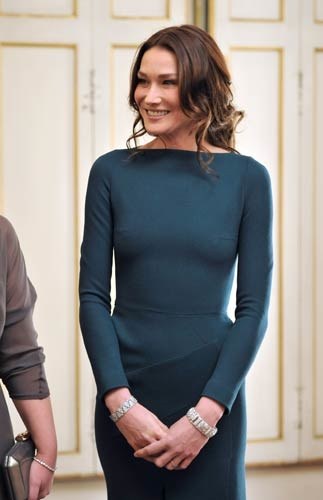More than a year ago, in a post titled “The Nipple Exposed,” I wondered why our public morality has grown increasingly prurient in its fascination with open displays of nipples. In extreme instances, an overzealous paternalism has led to the censorship of innocuous images. See this Bell Canada ad for a good example.

Just when I think things are smoothing themselves over, the nipple issue pops up again. The catalyst for this renewed attention is Carla Bruni, model and 3rd wife of French President, Nicolas Sarkozy. Last week, the first lady hosted a state dinner wearing a tight Roland Mouret dress and no underwire. The Times Online [link no longer exists] carried on a heated debate about the existence and nature of Bruni’s undergarments. The problem, it seems, is that her nipples were on prominent display. What could it possibly signify? In a statement that likely will make feminists everywhere wince, Hannah Betts writes:
Our culture is obsessed with heaving, blancmangey cleavage, but the erect nipple is a far more potent yet insouciant sexual signifier. The pert pap winningly protrudes between the sluttish and the demure: contained arousal, clothed incitement; an invitation more beguiling for being a whisper rather than a shout.
The nipple is an “insouciant sexual signifier”? I hope she’s being tongue-in-cheek. However, I’m inclined to agree with Kate Harding of Salon [link no longer exists] who suggests that Bruni probably had no intentions sexual or otherwise; she was merely caught in the unfortunate glare of strong camera flashes. The public significance of Bruni’s nipples is dependent entirely upon whatever thoughts we onlookers allow to pass through our heads. If we place Bruni somewhere between “the sluttish and the demure” then we are merely projecting onto a public figure our own mental garbage. Harding neatly concludes with:
And as long as a woman wearing a boatneck, long-sleeved, full-length gown with sensible low heels can be cast as trampy and inappropriate because she got photographed in unfortunate lighting and/or a drafty room — as long as the line highly visible females are expected to walk is that freakin’ fine — I really don’t want to hear one more word about how sexism has nothing to do with the lack of women in positions of real power.
I have nothing to add to the debate. I’ve had my say before. I merely point out that some people (and some media outlets) think this is somehow worthy of comment. It is that fact, and not the “insouciant sexual signifier,” which requires our critical attention.
